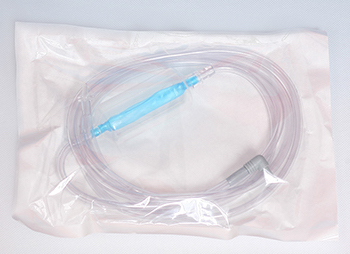Reduce tracheal tissue damage
Reduce aspiration and reduce vap
Timely discovery of airbag rupture
Prevent tracheal intubation from falling off
Reduce patient ICU retention time and mechanical ventilation time reduce medical expenses
Improve the efficiency of medical staff
Reduce medical disputes by following national guidelines
Airbag Pressure Monitor(Automatically Air Pump)
CHO-APM02

Description: It is suitable for the control of artificial airway airbag pressure in patients with cuffed airway during mechanical ventilation. Continuous and uninterrupted monitoring of cuff pressure and intelligent control, so that cuff pressure is always maintained within the pressure range specified in the Guide. Reduces the risk of ventilator-associated pneumonia (VAP) by 4-6 times.
◆ R & D background
Proper airway management is a critical process for treating critically ill patients with mechanical ventilation and preventing complications. Both are associated with tracheal intubation balloon pressure, resulting in damage to the tracheal tissue and subglottic secretions into the lungs. Based on extensive research and innovation in airway management, the airbag pressure monitor can continuously and dynamically control the tightness of the tracheal intubation and the pressure of the tracheal intubation cuff and keep it within the set range.
The Guidelines for the Diagnosis, Prevention and Treatment of Ventilator-Related Pneumonia (2013) issued by the Chinese Medical Association Critical Care Medicine Branch clearly states that patients with mechanical ventilation should regularly monitor the intra-tracheal catheter cuff pressure (2C); the control of the endotracheal tube is continuously controlled. The sac pressure reduces the incidence of VAP (2B).
The incidence of domestic VAP is 6% to 52%, and the mortality rate is 14% to 50%. Clinically, ICU patients were continuously monitored for balloon pressure within 8H, and only 18% of patients had a balloon pressure of 25-30 cmH2O. Another study feedback adjusted the cuff pressure three times a day, the cuff pressure was still only 36.7% of 25 ~ 30cmH2O, 60.2% of the cuff pressure was lower than 25cmH2O, the lowest value was 8cmH2O. 3.1% above 30cmH2O, up to 50cmH2O.
◆ Expert consensus (Chinese Medical Association Respiratory Diseases Respiratory Therapy Group)
Recommendation 3:
The pressure of the airbag should be maintained at 25-30cmH2O (recommended level: D).
An automatic air pump can be used to maintain the airbag pressure (recommended level: Class B);
◆ Advantage analysis
Reduce tracheal tissue damage
Reduce aspiration and reduce vap
Timely discovery of airbag rupture
Prevent tracheal intubation from falling off
Reduce patient ICU retention time and mechanical ventilation time, reduce medical expenses
Improve the efficiency of medical staff
Reduce medical disputes by following national guidelines
◆ Applicable department
ICU (Intensive Care)
NICU (Neurosurgery Intensive Care)
EICU (Emergency Intensive Care)
RICU (Respiratory Intensive Care)
CCU (Intensive Care for Coronary Heart Disease)
SICU (Surgical Critical Care)
MICU (Internal Intensive Care Unit)
BICU (Burst Severe) Intensive care unit)
AICU (anesthesia intensive care unit)
Anesthesiology, etc.
Accessory

This product is used for artificial airway use patients, the artificial airway cuff is connected with the airbag pressure monitor, so that the airbag pressure monitor can monitor and control the pressure of the artificial airway cuff placed with the cuff. In addition to the pneumatic connection, the monitoring tube has a pressure observation airbag to visually check the pressure in the artificial airway cuff.


